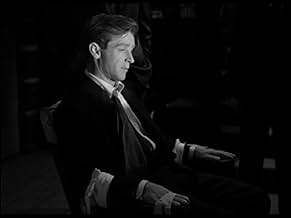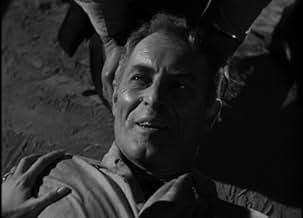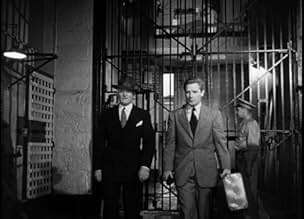Ajouter une intrigue dans votre langueA paroled convict's infatuation with a gold-digger nurse working at a sanitarium leads him to crime.A paroled convict's infatuation with a gold-digger nurse working at a sanitarium leads him to crime.A paroled convict's infatuation with a gold-digger nurse working at a sanitarium leads him to crime.
- Réalisation
- Scénario
- Casting principal
Harry Morgan
- Garth
- (as Henry Morgan)
Harry Antrim
- Dr. Stone
- (non crédité)
Joe Besser
- Cook
- (non crédité)
Peggie Castle
- Crossroads Tavern Waitress
- (non crédité)
Stephen Chase
- Bartender
- (non crédité)
Paul Dubov
- Stick-Up Man
- (non crédité)
Frank Gerstle
- Stick-Up Man
- (non crédité)
Anne P. Kramer
- Bertie, the Waitress
- (non crédité)
Ralph Montgomery
- Bar Customer
- (non crédité)
Tudor Owen
- Watchman
- (non crédité)
Avis à la une
10clanciai
Richard Baseheart never competed with such mega stars as Gregory Peck, Humphrey Bogart and John Wayne but kept more to himself concentrating on more complicated roles on a smaller scale, like a kind of understatement actor, but the result is that his roles are always interesting and intriguing. Here he is released from prison after fifteen years at the age of 29 and knows nothing about society. His only schooling in 15 years' imprisonment has been to handle tough guys and ruffians and a thorough knowledge of the criminal type. To get away from the stress and noise of Philadelphia, he heads for the country and finds a small friendly town where nothing ever happens, where he is employed as an assistant at a hospital. So far so good, but it is not. An old fellow gangster turns up in a dying state who has hidden a million away somewhere, and the fellow hoodlums he has fooled are after him, so he is not allowed to die in peace. Unfortunately Richard Baseheart is there, they recognise each other, and the case is cooked. From there on the strain and excitement of the thriller keeps constantly rising like a fever temperature, and a few dames get involved also. This is in many ways the perfect thriller, but Richard Baseheart's acting is what keeps it glowingly alive until it bursts into flames, and the finale is an ingenious climax of the composition.
OUTSIDE THE WALL is a solid B crime movie that delivers everything the genre promises. It might make a nice comparison with TOMORROW IS ANOTHER DAY, released the next year. In both films, an ex-con, newly released, runs into trouble despite their pretty naive aspirations and innocuous personalities.
Probably the main distinguishing characteristic of OUTSIDE THE WALL is the use of Philadelphia locations. It's always fascinating to see a large city back in the middle of the last century. We are usually shown L. A. or N. Y., the Pennsylvania metropolis makes a welcome change.
At the top of the cast list is Richard Basehart. Pretty much an asset in any film, Basehart carries the lead perfectly. His boyish good looks serve the character, a still-young man who never had a chance to experience the world before he was thrown into prison. When he's let out, Basehart meets a stream of women, most of them unworthy of his attentions. Marliyn Maxwell is also well-cast as a brittle, materialistic nurse whom Basehart encounters in his first legitimate job. Her influence leads him to rejoin the criminal life, and plenty of trouble ensues. Among the rest of the cast are Noir favorites, Joseph Pevney, the incredibly prolific John Hoyt and Harry Morgan (who here plays a crime boss with gusto), . Dolores Hart plays Basehart's possible love interest, while Signe Hasso is almost wasted as a money-hungry gangster's wife.
Probably the main distinguishing characteristic of OUTSIDE THE WALL is the use of Philadelphia locations. It's always fascinating to see a large city back in the middle of the last century. We are usually shown L. A. or N. Y., the Pennsylvania metropolis makes a welcome change.
At the top of the cast list is Richard Basehart. Pretty much an asset in any film, Basehart carries the lead perfectly. His boyish good looks serve the character, a still-young man who never had a chance to experience the world before he was thrown into prison. When he's let out, Basehart meets a stream of women, most of them unworthy of his attentions. Marliyn Maxwell is also well-cast as a brittle, materialistic nurse whom Basehart encounters in his first legitimate job. Her influence leads him to rejoin the criminal life, and plenty of trouble ensues. Among the rest of the cast are Noir favorites, Joseph Pevney, the incredibly prolific John Hoyt and Harry Morgan (who here plays a crime boss with gusto), . Dolores Hart plays Basehart's possible love interest, while Signe Hasso is almost wasted as a money-hungry gangster's wife.
The premise of a convict trying for a fresh start isn't a new one, but I liked the unique characterization or Richard Basehart in Outside the Wall. He plays a young man who's spent more than half his life in prison. While he was a fourteen-year-old in reform school, he beat up a guard (who later died) and was sentenced to murder. After fifteen years, he receives a pardon and is completely unprepared for the outside world. Think about it: the last time he saw the outside, he was a little boy. He's never driven a car, worked at a job, gone on a date, paid bills, or lived on his own. Thrust out into a new world, he gets a job working in a sanitarium and quickly falls for the first blonde who turns his head, Marilyn Maxwell. Dorothy Hart is the brunette nurse with a heart of gold, in contrast to Marilyn's obvious gold digging schemes. Will the innocent protagonist see through her, or will he have to grow up the hard way?
This old movie doesn't feel like it was made in 1950; it feels like it was made in the early 1930s. Everything about it is old-fashioned, from the good girl and bad girl contrast, to the simple filmmaking techniques, to the type of turns the plot takes. I kept expecting Chester Morris to show up with Carole Lombard, Kay Francis, and Shirley Temple. If you like old movies, and especially ex-con movies, try this one out.
This old movie doesn't feel like it was made in 1950; it feels like it was made in the early 1930s. Everything about it is old-fashioned, from the good girl and bad girl contrast, to the simple filmmaking techniques, to the type of turns the plot takes. I kept expecting Chester Morris to show up with Carole Lombard, Kay Francis, and Shirley Temple. If you like old movies, and especially ex-con movies, try this one out.
In the Hollywood of late '40s and early '50s, Richard Basehart found plenty of work in the noir cycle but never made a major mark, the mark of a Robert Mitchum or Glenn Ford or even a Dick Powell. His good looks were all-American bland - lackluster - and his acting rarely leapt to dangerous voltages. Probably more at home on stage than on the pitiless screen, he leaves one of his fullest performances in a shunted-aside noir, Outside The Wall.
Just 30 but with 15 years in stir behind him (he'd caused the death of an abusive guard when he was just a kid in reform school), he secures an unexpected release from prison. An old lifer grumbles about life outside: `Everybody's got the jitters. A buck ain't worth a buck anymore.' But mo st of all he warns about the `dames,' of whom Basehart knows absolutely nothing. He'll soon find out.
In his first night in Philadelphia, a B-girl feeds him his first taste of liquor and tries to filch his wallet; later, washing dishes, he foils a stickup and, fed up with Brotherly Love, heads for the clean country of Jewel Lake, landing a job as a lab technician at a TB sanitarium. His first patient (John Hoyt) turns out to be an ex-con he knows who's just pulled a fatal armored-car robbery. When Basehart fails to blow the whistle, the dying Hoyt trusts him enough to mule payoff money to his avaricious wife (Signe Hasso).
The straight-arrow Basehart normally wouldn't dirty his hands, but the blonde and mercenary charms of nurse Marilyn Maxwell lead him to rethink his monkish life (`I just found out what money can buy,' he tells her, forking over a platinum bracelet in his new roadster). Still, his stirring conscience beckons him to fess up about his past to good-gal Dorothy Hart. But Hoyt has the means to hold him to his bargain, while his wife and her ruthless accomplices have their own plans for him....
Crane Wilbur, who started way back in the silent era, wrote several noirs and directed a few of them, mostly about prison life (Canon City, The Story of Molly X). Here, he directs his story with some nicely observed vignettes about the dislocation awaiting released felons but, as it advances, less than persuasive plotting. But, in addition to the convincing work he coaxes from Basehart, he assembles a solid cast, with Maxwell and Hasso rivaling one another in duplicity and Hart more appealing than the saintly simp she might have been.
Harry Morgan also appears, as a thug who elicits information by sliding scalpels under fingernails. Interestingly a veteran of even more noirs than Basehart, Morgan played the heavy the year before, too, in Red Light, but couldn't hold a candle to his partner in crime, Raymond Burr. Here, he takes his place amid a balanced cast with intersecting motives that result in a movie that, while satisfying, falls well short of spectacular. Still, it merits more viewers.
Just 30 but with 15 years in stir behind him (he'd caused the death of an abusive guard when he was just a kid in reform school), he secures an unexpected release from prison. An old lifer grumbles about life outside: `Everybody's got the jitters. A buck ain't worth a buck anymore.' But mo st of all he warns about the `dames,' of whom Basehart knows absolutely nothing. He'll soon find out.
In his first night in Philadelphia, a B-girl feeds him his first taste of liquor and tries to filch his wallet; later, washing dishes, he foils a stickup and, fed up with Brotherly Love, heads for the clean country of Jewel Lake, landing a job as a lab technician at a TB sanitarium. His first patient (John Hoyt) turns out to be an ex-con he knows who's just pulled a fatal armored-car robbery. When Basehart fails to blow the whistle, the dying Hoyt trusts him enough to mule payoff money to his avaricious wife (Signe Hasso).
The straight-arrow Basehart normally wouldn't dirty his hands, but the blonde and mercenary charms of nurse Marilyn Maxwell lead him to rethink his monkish life (`I just found out what money can buy,' he tells her, forking over a platinum bracelet in his new roadster). Still, his stirring conscience beckons him to fess up about his past to good-gal Dorothy Hart. But Hoyt has the means to hold him to his bargain, while his wife and her ruthless accomplices have their own plans for him....
Crane Wilbur, who started way back in the silent era, wrote several noirs and directed a few of them, mostly about prison life (Canon City, The Story of Molly X). Here, he directs his story with some nicely observed vignettes about the dislocation awaiting released felons but, as it advances, less than persuasive plotting. But, in addition to the convincing work he coaxes from Basehart, he assembles a solid cast, with Maxwell and Hasso rivaling one another in duplicity and Hart more appealing than the saintly simp she might have been.
Harry Morgan also appears, as a thug who elicits information by sliding scalpels under fingernails. Interestingly a veteran of even more noirs than Basehart, Morgan played the heavy the year before, too, in Red Light, but couldn't hold a candle to his partner in crime, Raymond Burr. Here, he takes his place amid a balanced cast with intersecting motives that result in a movie that, while satisfying, falls well short of spectacular. Still, it merits more viewers.
Not RIOT IN CELL BLOCK 11 nor BRUTE FORCE, nor THE LAST MILE either. But it is actually a movie about an ex jail bird who was condemned for manslaughter, and who, after his release from prison, encounters many issues. Nothing really exciting, but it is an Universal crime drama, rather hard to find, and Richard Basehart is an actor who is always interesting to see in a movie, especially a thriller. The funny thing is that after this one - OUTSIDE THE WALL - director Crane Wilbur will give us INSIDE THE WALLS OF FOLSOM, and I don't even speak of his CANON CITY, made before this one. Also both prison break plots. Good little noir, pretty much enjoyable.
Le saviez-vous
- AnecdotesJoe Besser appears uncredited as a the diner owner who is held up at gun point early in the film. He later gained fame as a member of the Three Stooges briefly from 1957-59.
- GaffesAt the end of the film when dying criminal Jack Bernard (played by John Hoyt) falsely and vindictively attempts to incriminate Larry Nelson (Richard Basehart) to the police as being his former accomplice in the armoured car robbery, all Larry would have had to do in order to clear himself would be to have his true identity verified by the authorities of the Philadelphia prison from which he had recently been released.
- Citations
Charlotte Maynard: You've got hands like iron. A girl wouldn't have much chance if you really got sore.
Meilleurs choix
Connectez-vous pour évaluer et suivre la liste de favoris afin de recevoir des recommandations personnalisées
- How long is Outside the Wall?Alimenté par Alexa
Détails
- Date de sortie
- Pays d’origine
- Langue
- Aussi connu sous le nom de
- Outside the Wall
- Lieux de tournage
- Eastern State Penitentiary - 2124 Fairmont Avenue, Philadelphie, Pennsylvanie, États-Unis(early exterior and interior scenes)
- Société de production
- Voir plus de crédits d'entreprise sur IMDbPro
- Durée1 heure 20 minutes
- Couleur
- Rapport de forme
- 1.37 : 1
Contribuer à cette page
Suggérer une modification ou ajouter du contenu manquant

Lacune principale
By what name was J'ai grandi en prison (1950) officially released in India in English?
Répondre



































